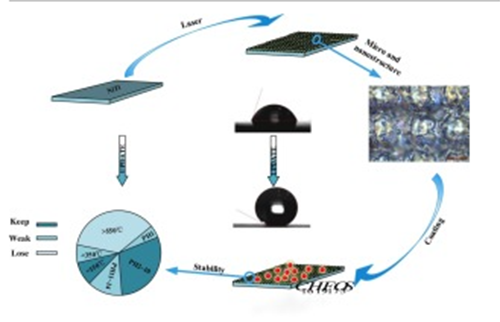Copyright © 2022 Foshan MBRT Nanofiberlabs Technology Co., Ltd All rights reserved.Site Map
In this paper, superhydrophobic surfaces were fabricated on nitinol alloy by utilizing nanosecond laser and silanization process. Grid pattern surfaces are obtained by adjusting the adjacent scanning path from 60 μm to 100 μm and increasing 10 μm by step, which named g60, g70, g80, g90 and g100 respectively. Silanization process is performed to achieve surface chemical modification to lower the surface energy. The water contact angle (WCA) measurements show that g80 surfaces has the largest WCA which is 154.42°±2.1° and g60 has the smallest WCA which is 152.16°±1.25°. The chemical stability against acid, alkaline, organic solvent and salt water and thermal stability of surfaces are also investigated. The results show that modified superhydrophobic nitinol surfaces have a strong stability against acid solution, organic solvent and salt water, but slightly weak stability against alkaline solution. Furthermore, modified surfaces can keep superhydrophobicity under 150 °C, and hydrophobicity under 350 °C but becomes hydrophilic when the temperature exceeds 550 °C. This report will provide significant theoretical basis for extending the applications of shape memory alloy (nitinol) in a lot of areas such as microfluidic devices, bio-mimetic materials fabrication and lab on chip.

Published: 2019
Journal:COLLOID SURFACE A
Impact Factor:4.21
Paper link:https://www.sciencedirect.com/science/article/abs/pii/S0927775719300342